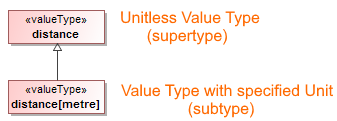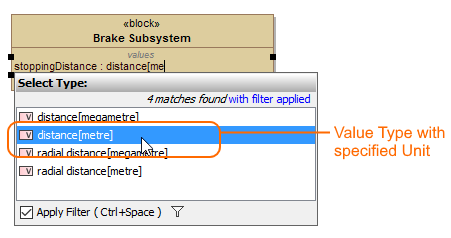A Value Type is defined as a stereotype of UML Data Type to establish a more neutral term for system values that may never be given a concrete data representation. A Value Type adds an ability to carry a units of measure of a Quantity Kind associated with the value.
Use the QUDV model library to find all standard value types.
When specifying the Value Type for a Value Property, you can select one of the following:
- Unitless Value Type.
- Value Type with specified unit.
Look at the table below to see the differences.
- If you cannot find the Value Type you need, you can create a custom Value Type. Learn how to create a custom Value Type >>
- If you cannot find the unit you need, you can create a custom Unit. Learn how to create a custom units >>
If you want to specify the Value Type for a Value Property, follow the procedures in the Using Units page.
| Value Type | Name construction | Purpose | Example |
|---|---|---|---|
| Unitless | Quantity name, e.g. distance. | Use this to create a general-purpose model. Instance Specifications and its Slots can contain different units of the same Block. | |
| With specified units | Quantity and unit names, e.g. distance[metre]. | Use this to create a specific-purpose model. Instance Specifications and its Slots can contain the same units of the same Block. |
Related diagrams


